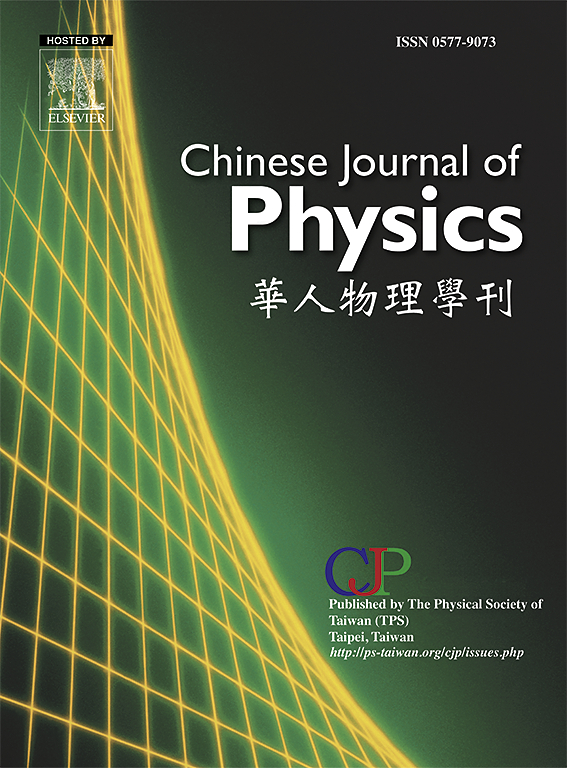Application of computational fluid dynamics and physics informed neural networks in predicting rupture risk of thoracoabdominal aneurysms with fluid-structure interaction analysis
IF 4.6
2区 物理与天体物理
Q1 PHYSICS, MULTIDISCIPLINARY
引用次数: 0
Abstract
An aneurysm’s rupture is often linked to its maximum diameter, but biomechanical studies highlight the crucial role of hemodynamic factors, such as blood flow pattern and pressure within the blood vessel, in this process. This study investigates six cases, exploring both axisymmetric (fusiform) and asymmetric (saccular) aneurysm shapes while maintaining a consistent aneurysm diameter and varying the bulge shape factor to induce asymmetry. Hemodynamic factors, including wall shear stress (WSS), wall shear stress gradient (WSSG), and von Mises stress distributions, are computed under both laminar and turbulent flow conditions, reflecting the diastolic and systolic phases, respectively. Our results reveal that recirculation zones, particularly prominent in asymmetric cases, generate vortices within the aneurysm, increasing blood residence time and the likelihood of thrombus formation. Thrombus formation can impede blood flow, raising the risk of embolism or ischemic events. Rupture occurs when WSS exceeds tissue strength, and our findings suggest that rupture risk varies with aneurysm asymmetry. Specifically, hemodynamic factors are more severe in turbulent cases, with the highest values observed in case 2-T, an asymmetric aneurysm with a significant posterior bulge. This case also shows the highest rupture risk, indicated by elevated WSS, WSSG, and von Mises stress, particularly on the anterior side, towards the distal end of the thoracic aortic aneurysm. At this location, the high WSS and WSSG indicate intense fluctuations and flow disturbances, while von Mises stress is also significantly elevated, further increasing the likelihood of rupture. Additionally, we used a synergistic approach that integrates Computational Fluid Dynamics (CFD) with Physics-Informed Neural Networks (PINNs) to compare pressure and velocity distributions along the medial and transverse planes, demonstrating strong agreement. A novel aspect of this study lies in its comprehensive analysis of thoracoabdominal aneurysms, accounting for the influence of aneurysm asymmetry on WSS, WSSG, and von Mises stress. Additionally, both laminar and turbulent flow conditions are explored to reflect the diastolic and systolic phases, respectively.
应用计算流体力学和物理信息神经网络预测胸腹动脉瘤的破裂风险与流固耦合分析
动脉瘤的破裂通常与其最大直径有关,但生物力学研究强调了血流动力学因素在这一过程中的关键作用,例如血管内的血流模式和压力。本研究调查了6例病例,探讨了轴对称(梭状)和不对称(囊状)动脉瘤形状,同时保持一致的动脉瘤直径和改变凸起形状因子来诱导不对称。计算了层流和湍流条件下的血流动力学因子,包括壁面剪切应力(WSS)、壁面剪切应力梯度(WSSG)和von Mises应力分布,分别反映了舒张期和收缩期。我们的研究结果表明,再循环区,特别是在不对称的情况下,在动脉瘤内产生漩涡,增加血液停留时间和血栓形成的可能性。血栓形成会阻碍血液流动,增加栓塞或缺血性事件的风险。当WSS超过组织强度时发生破裂,我们的研究结果表明破裂风险因动脉瘤不对称而异。具体来说,血流动力学因素在湍流病例中更为严重,在病例2-T中观察到的数值最高,这是一个不对称的动脉瘤,具有明显的后部隆起。该病例也显示出最高的破裂风险,表现为WSS、WSSG和von Mises应力升高,尤其是在胸主动脉瘤远端前侧。在这个位置,高WSS和WSSG表明强烈的波动和流动干扰,同时von Mises应力也显著升高,进一步增加了破裂的可能性。此外,我们使用了一种协同方法,将计算流体动力学(CFD)与物理信息神经网络(pinn)相结合,比较了沿内侧和横向平面的压力和速度分布,结果显示出了很强的一致性。本研究的新颖之处在于其对胸腹动脉瘤的综合分析,考虑了动脉瘤不对称对WSS、WSSG和von Mises应力的影响。此外,层流和湍流两种流动条件分别反映了舒张期和收缩期。
本文章由计算机程序翻译,如有差异,请以英文原文为准。
求助全文
约1分钟内获得全文
求助全文
来源期刊

Chinese Journal of Physics
物理-物理:综合
CiteScore
8.50
自引率
10.00%
发文量
361
审稿时长
44 days
期刊介绍:
The Chinese Journal of Physics publishes important advances in various branches in physics, including statistical and biophysical physics, condensed matter physics, atomic/molecular physics, optics, particle physics and nuclear physics.
The editors welcome manuscripts on:
-General Physics: Statistical and Quantum Mechanics, etc.-
Gravitation and Astrophysics-
Elementary Particles and Fields-
Nuclear Physics-
Atomic, Molecular, and Optical Physics-
Quantum Information and Quantum Computation-
Fluid Dynamics, Nonlinear Dynamics, Chaos, and Complex Networks-
Plasma and Beam Physics-
Condensed Matter: Structure, etc.-
Condensed Matter: Electronic Properties, etc.-
Polymer, Soft Matter, Biological, and Interdisciplinary Physics.
CJP publishes regular research papers, feature articles and review papers.
 求助内容:
求助内容: 应助结果提醒方式:
应助结果提醒方式:


